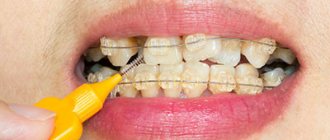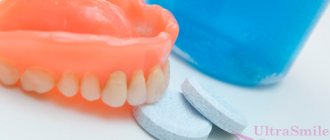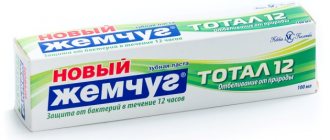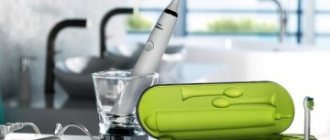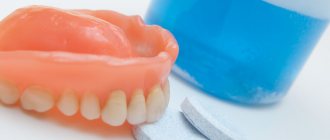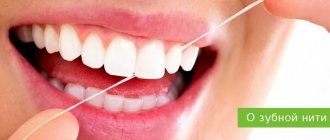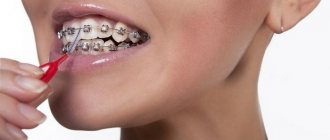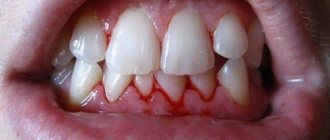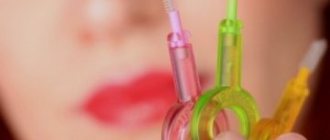Floss is a dental floss that allows you to clean teeth in hard-to-reach places and removes plaque from the surface. This is a hygiene aid and does not replace regular cleaning and rinsing of the mouth .
Using this product, you can eliminate the smallest food debris, thereby protecting the enamel from carious lesions.
Efficiency
Caries prevention is possible by brushing your teeth twice a day. The reproduction of bacteria is stopped, since they cannot live on a clean surface. However, the brush only copes with the internal and external areas. Meanwhile, food particles get stuck in the spaces between the teeth, where the bristles of the brush cannot penetrate.
As a result, pathogenic bacteria develop vigorous activity as food decomposes. The prerequisites for the formation of caries are created. The next stage is the appearance of carious cavities.
Use a thread to clean hard-to-reach areas. It is important to floss with a broken bite and with teeth located close to each other. It is partially possible to sanitize the cavities between the surface of the tooth and the gum - pockets. They are formed during periodontitis, and if you don’t take care of them, you can lose a tooth.
Kinds
Flosses differ in the processing method:
- waxed;
- not waxed.
In the first case, the thread is covered with a thin layer of wax. This facilitates easy sliding and unhindered removal of deposits.
The “tool” is made from:
- silks;
- nylon;
- nylon;
- acetate.
Natural silk is rare. It was originally used when floss first appeared. Today, mostly artificial options are presented on pharmacy shelves.
The threads are made according to the shape:
- flat;
- round;
- tape
Dr. Zubastik advises purchasing the first ones for people with tightly spaced teeth, the second and third ones for those with wide gaps.
The floss subtype with the prefix “super” is intended for those who wear braces. This design consists of several parts. But we'll talk about it a little later.
Non-waxed threads can be used by those who have experience in cleaning the interdental space with floss. It is believed that they cope better with this task.
Waxed ones are convenient for beginners. The thread does not get stuck anywhere, glides freely, and does not split. There is no risk that a piece of it will remain between the teeth.
To increase the effect, floss is impregnated with therapeutic and prophylactic drugs. This:
- sodium fluoride (prevention of caries);
- chlorhexidine (disinfection);
- menthol (breath freshens).
You should choose a floss only after consulting a doctor, because when choosing it on your own, you may not take into account the peculiarities of the condition of your teeth and gums, as a result of which, instead of benefiting your health, you will cause harm to your health.
What is superfloss?
Superfloss is dental floss that has different shapes in different areas. It is used to clean orthodontic structures, implants, bridges and braces .
Most superfloss is regular dental floss. This area is used to clean out gum pockets. The pointed tail is necessary for cleaning under the bracket arch.
The thickened part is made of sponge material. It is designed for cleaning braces with a lock. To avoid damaging the orthodontic structure, you should consult your doctor in advance.
Use it correctly
There are 2 approaches to flossing teeth:
- Before carrying out the usual hygiene procedure using a brush and paste.
- After morning or evening cleansing is completed.
The first approach is closer to American dentists. They advise cleaning hard-to-reach areas before picking up a brush and starting the usual procedure. In Russia, doctors often recommend operations in the reverse order: brush your teeth, floss.
Regardless of what order you follow, the following rules are mandatory:
- Wash your hands.
- Cut a piece of floss 30-40 cm long.
- Take it so that part is wound around the middle finger of your right hand, and pinch part between the thumb, index and middle fingers of your left hand.
- Place the strip behind the tooth, trying to grab it, and move it up and down.
- Start with the upper jaw.
Remember : you cannot use one piece twice! If there is food or bacteria left on it, it can be transferred to the adjacent tooth. Inflammation will arise, and you will end up with what you were running away from: caries.
If there are no special recommendations from the dentist, then carry out the procedure once a day.
What if I have braces?
Regular oral care with floss is required.
Braces can become a source of infection if they are not cared for properly. Complete cleaning with a brush is not possible. The smallest particles - food debris and harmful bacteria - are located in the places of fastening.
Step 1
Step 2
Step 3
Step 4
To avoid this, make it a rule to keep dental floss in the bathroom and regularly do “spring cleaning.”
You will need waxed floss - they will not touch the elements of the system. The second, more reliable way is to buy superflosses. The difference is this: superfloss is made of three materials. There are:
- hard fiber;
- sponge fiber;
- synthetic thread.
The principle of use is the same as for a regular one, only the result is achieved faster.
Finally, superfloss
Examples of superfloss: Miradent or Oral-B. With braces in place, if you're just starting to master the art of flossing, also try Sensodyne Floss or Lacalut.
Popular brands
There are many companies that produce floss. Most often these are well-known brands that produce toothpastes, brushes, brushes and other devices for hygienic teeth cleaning.
Popular ones include the following manufacturers :
- Oral-B;
- SPLAT;
- Jordan Expand;
- ROCS;
- Colgate;
- Lacalut.
Dental floss from the manufacturer Oral-B (Oral bi satin floss) is one of the most popular.
They are quite durable and allow you to penetrate even the narrowest spaces between teeth. Available in skeins of 25 and 50 m. There is not only a standard thread, but also a variety with mint impregnation.
SPLAT company has several types: super thin with silver and waxed with different scents. All products from this manufacturer are impregnated with a special antibacterial agent.
Jordan Expand company produces bulky threads. Their advantage is that during use they delaminate, thereby cleaning more space. Such threads are impregnated with fluoride or mint-flavored toothpaste.
For your information! Jordan Expand flosses are not suitable for cleaning very narrow spaces between teeth.
Dental floss from ]ROCS[/anchor] has a mint impregnation. It is perfect for people with sensitive gums, as well as for patients with fluorosis. Such products do not contain fluorine.
Colgate flosses are used to prevent the formation of tartar. They are soaked in mint extract, so they freshen your breath well. Lacalut threads are coated with wax. They are recommended for use by those who have not yet encountered the use of floss. There are models with a cross section.
Crowns are not an obstacle
Many people are wary of advice to use floss if part of the teeth are covered with crowns. This fear is unfounded: such teeth also require careful care. The material that is placed between the crown and living tissue dissolves over time. Bacteria and plaque accumulate in these places. It must be cleaned off, because otherwise inflammation of the adjacent soft tissues is possible. This is fraught with the development of periodontitis.
We brush in the same way as usual, without distinguishing between “live” teeth and those covered with a crown. It is especially important to observe this rule in relation to metal ceramics. It is convenient to use superfloss.
Recommendations for children
Dental floss is recommended for adults. In childhood, use is not always advisable. Dentists do not recommend using it under 12 years of age because:
- the mucous membrane is delicate and easy to injure;
- not all milk teeth were replaced by permanent ones;
- The child’s movements can be sudden, which sometimes causes bleeding gums and inflammation.
After reaching the age of 12, and with the approval of the dentist, a teenager can floss their teeth. The first session should be conducted under parental supervision.
How to choose?
The choice of manufacturer and specific type of product should be based on the condition of the teeth , as well as the individual structure of the dentition . It is best for a doctor to select such a product.
If there are no dental diseases and the teeth are not closely spaced, it is recommended to use non-waxed dental floss with a round cross-section .
The type of impregnation can be any depending on individual preferences. For twisted teeth , as well as during the inflammatory process, floss in the form of tapes with bactericidal impregnation can be used .
Waxed is perfect for cleaning narrow spaces. Due to its coating, it will easily pass between the teeth. To clean teeth with weakened enamel or initial carious lesions, it is recommended to use threads impregnated with fluoride preparations .
Toothbrush or floss
The natural question is: why do I need floss if I always brush my teeth twice a day with a modern brush, the manufacturer of which promises that it provides penetration into the “most difficult to reach places”?
Despite the improved shape of the brush, it is not able to achieve the degree of cleaning that the thread provides. The villi do not penetrate into the gaps between the teeth. This means that part of the plaque remains untouched.
At the same time, the brush is safer: if you carry out hygiene procedures 2–4 times a day, it is impossible to cause injury. Floss should not be used more than once a day.
Floss does not clean the front or back surfaces. Therefore, these hygiene items are not interchangeable. They complement each other.
Indications for use
Flosses are used to clean hard-to-reach spaces and crowded teeth. Indications for use :
- periodontal diseases;
- the presence of non-removable orthopedic or orthodontic structures;
- approximal fillings;
- the presence of an implanted implant.
Doctors recommend using floss, since a toothbrush is not able to completely clean teeth of food debris. The product can be used for gingivitis that is not accompanied by gum recession.
special instructions
Like any therapeutic and prophylactic method, the process of flossing teeth has contraindications. Avoid this oral care method if you have:
- caries has been diagnosed and not yet healed (pieces of teeth affected by microbes break off);
- gums bleed;
- Many crowns, bridges and implants have been installed.
The last case is a relative contraindication. Doctors allow and even recommend dental floss, but only after a thorough examination of the oral cavity. Old crowns and bridges are replaced and approval is given for the purchase of floss.
Contraindications
Floss has its contraindications for use. Such a product should be discarded if there are carious lesions . In this case, dental floss can lead to chipping of hard tissues.
Other contraindications include the following dental diseases:
- pulpitis;
- periodontal disease;
- bleeding gums.
When using the product during such diseases, activation of the inflammatory process and the formation of wounds on the gums is possible .
Attention! Before using such a dental device, you should consult a doctor and carry out a complete sanitation of the oral cavity.
Advice from Dr. Zubastik
Strips or threads are a universal remedy for maintaining healthy teeth and gums. Therefore, use them along with a brush. But follow your dentist's recommendations. So, let me remind you:
- Brush your teeth carefully! Excessive force can cause wounds and microtrauma to the gums.
- If you do touch the gum and see blood, stop the procedure and rinse your mouth with warm, salty water. Do not floss until the tissue is completely healed.
- Once a day is enough. Don't go overboard with your desire for cleanliness.
- Get your children used to flossing and tell them in advance about the benefits of the hygiene product.
- If there are contraindications, visit your dentist for advice. You may be allowed to buy floss after treatment.
Useful video:
Don't forget the main thing: oral care should be regular! Only then will it guarantee the absence of pathologies. Take care of your teeth and gums, and they will remain healthy until old age.
Tags: dental floss, floss, teeth cleaning
About the author: Dr. Zubastik
Typically, a toothache begins to subside on the way to the clinic and finally goes away after 10 minutes of sitting in line to see the dentist.
- Related Posts
- Who needs dental hygiene and why?
- Step-by-step instructions in pictures on how to brush your teeth and do it correctly
- 6 recommendations after brushing teeth from tartar
« Previous entry
